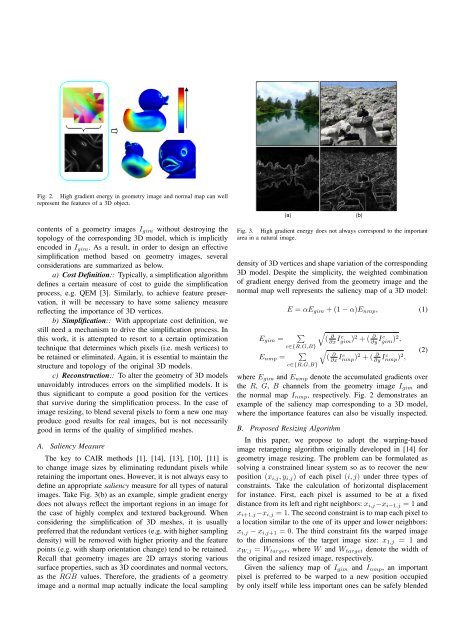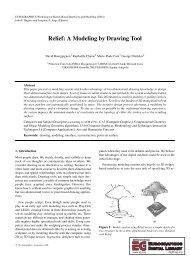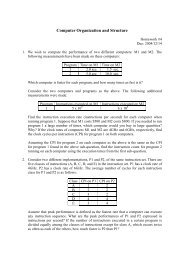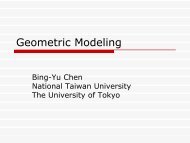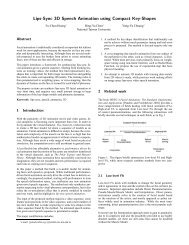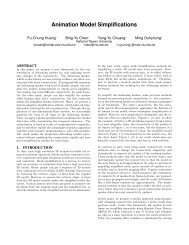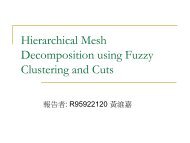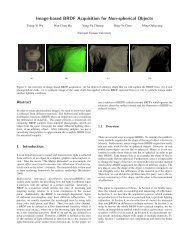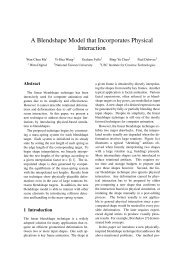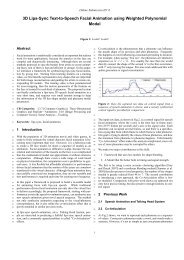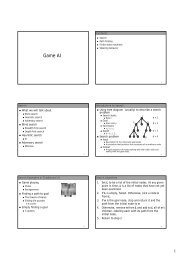Content-Aware Geometry Image Resizing - Computer Graphics ...
Content-Aware Geometry Image Resizing - Computer Graphics ...
Content-Aware Geometry Image Resizing - Computer Graphics ...
Create successful ePaper yourself
Turn your PDF publications into a flip-book with our unique Google optimized e-Paper software.
Fig. 2. High gradient energy in geometry image and normal map can well<br />
represent the features of a 3D object.<br />
(a)<br />
(b)<br />
contents of a geometry images I gim without destroying the<br />
topology of the corresponding 3D model, which is implicitly<br />
encoded in I gim . As a result, in order to design an effective<br />
simplification method based on geometry images, several<br />
considerations are summarized as below.<br />
a) Cost Definition:: Typically, a simplification algorithm<br />
defines a certain measure of cost to guide the simplification<br />
process, e.g. QEM [3]. Similarly, to achieve feature preservation,<br />
it will be necessary to have some saliency measure<br />
reflecting the importance of 3D vertices.<br />
b) Simplification:: With appropriate cost definition, we<br />
still need a mechanism to drive the simplification process. In<br />
this work, it is attempted to resort to a certain optimization<br />
technique that determines which pixels (i.e. mesh vertices) to<br />
be retained or eliminated. Again, it is essential to maintain the<br />
structure and topology of the original 3D models.<br />
c) Reconstruction:: To alter the geometry of 3D models<br />
unavoidably introduces errors on the simplified models. It is<br />
thus significant to compute a good position for the vertices<br />
that survive during the simplification process. In the case of<br />
image resizing, to blend several pixels to form a new one may<br />
produce good results for real images, but is not necessarily<br />
good in terms of the quality of simplified meshes.<br />
A. Saliency Measure<br />
The key to CAIR methods [1], [14], [13], [10], [11] is<br />
to change image sizes by eliminating redundant pixels while<br />
retaining the important ones. However, it is not always easy to<br />
define an appropriate saliency measure for all types of natural<br />
images. Take Fig. 3(b) as an example, simple gradient energy<br />
does not always reflect the important regions in an image for<br />
the case of highly complex and textured background. When<br />
considering the simplification of 3D meshes, it is usually<br />
preferred that the redundant vertices (e.g. with higher sampling<br />
density) will be removed with higher priority and the feature<br />
points (e.g. with sharp orientation change) tend to be retained.<br />
Recall that geometry images are 2D arrays storing various<br />
surface properties, such as 3D coordinates and normal vectors,<br />
as the RGB values. Therefore, the gradients of a geometry<br />
image and a normal map actually indicate the local sampling<br />
Fig. 3. High gradient energy does not always correspond to the important<br />
area in a natural image.<br />
density of 3D vertices and shape variation of the corresponding<br />
3D model. Despite the simplicity, the weighted combination<br />
of gradient energy derived from the geometry image and the<br />
normal map well represents the saliency map of a 3D model:<br />
E gim =<br />
E nmp =<br />
E = αE gim +(1−α)E nmp , (1)<br />
∑<br />
c∈{R,G,B}<br />
∑<br />
c∈{R,G,B}<br />
√<br />
( ∂<br />
∂x Ic gim )2 +( ∂<br />
∂y Ic gim )2 ,<br />
√<br />
( ∂<br />
∂x Ic nmp) 2 +( ∂<br />
∂y Ic nmp) 2 ,<br />
where E gim and E nmp denote the accumulated gradients over<br />
the R, G, B channels from the geometry image I gim and<br />
the normal map I nmp , respectively. Fig. 2 demonstrates an<br />
example of the saliency map corresponding to a 3D model,<br />
where the importance features can also be visually inspected.<br />
B. Proposed <strong>Resizing</strong> Algorithm<br />
In this paper, we propose to adopt the warping-based<br />
image retargeting algorithm originally developed in [14] for<br />
geometry image resizing. The problem can be formulated as<br />
solving a constrained linear system so as to recover the new<br />
position (x i,j ,y i,j ) of each pixel (i,j) under three types of<br />
constraints. Take the calculation of horizontal displacement<br />
for instance. First, each pixel is assumed to be at a fixed<br />
distance from its left and right neighbors:x i,j −x i−1,j = 1 and<br />
x i+1,j −x i,j = 1. The second constraint is to map each pixel to<br />
a location similar to the one of its upper and lower neighbors:<br />
x i,j −x i,j+1 = 0. The third constraint fits the warped image<br />
to the dimensions of the target image size: x 1,j = 1 and<br />
x W,j = W target , where W and W target denote the width of<br />
the original and resized image, respectively.<br />
Given the saliency map of I gim and I nmp , an important<br />
pixel is preferred to be warped to a new position occupied<br />
by only itself while less important ones can be safely blended<br />
(2)


